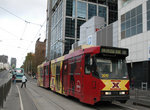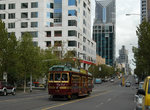Melbourne, Australia
![]()
Melbourne W5/SW5 Class (1935-1939) 842 at Flinders/Market. City Circle, clockwise loop. Photo by Peter Ehrlich.
Overview
Quite simply, the tramway system in Melbourne, Australia, is one of the greatest in the world, and is most certainly the largest in the English-speaking world. Every day, more than 500 trams of eight different varieties take to the streets and operate over 238 route kilometers and 28 distinct major routes and two dozen or so part-time or short-turn routes.
Melbourne's tram system essentially began in 1885, with the opening of a cable tram network, with the first line being operated by the Melbourne Tramway and Omnibus Company. The first electric trams came to the Box Hill area east of Melbourne in 1889, following the Great Exposition of 1888. But the first serious electric tram service opened in 1905, with the North Melbourne Electric Tramway and Lighting Company (NMETL), who built a line from the edge of the cable system out towards Essendon (north of Melbourne), and the Victorian Railways who built a line from St. Kilda to Brighton, south of Melbourne--an extension of its suburban railway system.
In other parts of Melbourne, groups of local councils got together and formed various municipal Tramways Trusts to build electric lines which fed the cable system. Except for the Hawthorn Tramways Trust (HTT) line to Princes Bridge, none were able to penetrate the dense cable tram network to reach the city directly. First among these trusts was the Prahran and Malvern Tramways Trust (PMTT), which started operations in 1910. Its first trams were of the "California" type similar to today's cable cars in San Francisco. But in 1913, PMTT double-truck drop-center combination cars were introduced, starting the design trend which spread all the way across Australia.
By 1923, the Melbourne and Metropolitan Tramways Board (M&MTB) had taken over both the various electric tramway trusts and the cable car system, and developed Melbourne's most famous tram type, the long- lived W class. The Ws, in their first incarnation, the W1 and W2 classes, were first produced in 1923, and the newest W7 class, some 40 units, were last manufactured in 1956. Retired by 1987, dozens of W2 have established second careers in tramway museums across Australia, and in regular service in New Zealand and especially the United States, where W2s provide daily service in San Francisco, Memphis and other locales. Today, the W class still plies Melbourne streets on three distinct routes, utilizing 53 W5, W6 and W7 trams. As Ws entered service, many of the multitude of inherited single- truck and older double-truck trams were sold to the State Electric Commission of Victoria for service in Bendigo, Ballarat and Geelong.
By 1940, the last of Melbourne's cable trams had been replaced, and the status quo was maintained throughout the 1940s and into the 1950s, when pressure to replace the trams mounted, mostly from the press. Unlike other cities in the world, Melbourne resisted mass conversion to buses, and there was one man who stood front and center at the head of the resistance: Sir Robert Risson. He ruled the M&MTB with an iron hand for well over two decades. It helped that the tramway union insisted on two-person crews on both trams and buses, making the conversion to buses uneconomical. By the 1970s, when the famous Ws began to wear out, even the Victorian state government began to realize that the M&MTB's investment in trams and the tramway system made economic sense.
In fact, there really have been only two retrenchments since the 1950s, when the Victorian Railways' two tram lines bit the dust in 1956 and 1969, and up in remote Footscray, where some shuttle routes were replaced by buses.
New Z class trams began replacing Ws in 1975, and the last Z3s arrived in 1984. The Z3s were the first with chopper control, a big improvement. Then wider A class cars arrived on the scene between 1984 and 1986, followed by Melbourne's first 6-axle articulated trams, 132 B class cars, the last entering in service in 1994.
In the 1990s, the M&MTB's tramroutes were divided among four privately-operated tram companies, as the government at the time believed that efficiencies and economies would be realized. In fact, this was not the case, and the surviving company, Yarra Trams, operates the entire network today. Some improvements have been made, such as extensions to some lines on the east side, and the introduction of new low-floor trams, the French Citadis and the German Combino. But the major improvement was reorganization of the fare structure, with the introduction of MetCard, which allows riders to take journeys on all trams, commute trains and buses all over the Melbourne region.
In 2000, all of the W class were suddenly withdrawn, over concerns about their braking. 53 of these have since been reintroduced on lines 30 (Docklands/St. Vincents Plaza via La Trobe Street); Line 35 (City Circle), and Lines 78/79 (Nth Richmond/Prahran or St. Kilda Beach crosstown). The City Circle takes riders past most major tourist attractions and into the developing Docklands area, crossing major trunk services on Bourke and Collins Streets (east-west) and William, Elizabeth and Swanston Streets (north-south services).
Getting around Melbourne by tram is a cinch. Yarra Trams' slogan is "Melbourne All Over", and these words appear on most Z-class and newer trams.
Photo Gallery
| Five Random Images | ||||
 Image 74627 (183k, 864x574) Photo by: Peter Ehrlich |  Image 74654 (158k, 864x574) Photo by: Peter Ehrlich |  Image 74700 (204k, 864x574) Photo by: Peter Ehrlich |  Image 76224 (186k, 864x574) Photo by: Peter Ehrlich |  Image 76329 (205k, 864x574) Photo by: Peter Ehrlich |
Links
Light Rail Transit Association
Page Credits
By Peter Ehrlich.